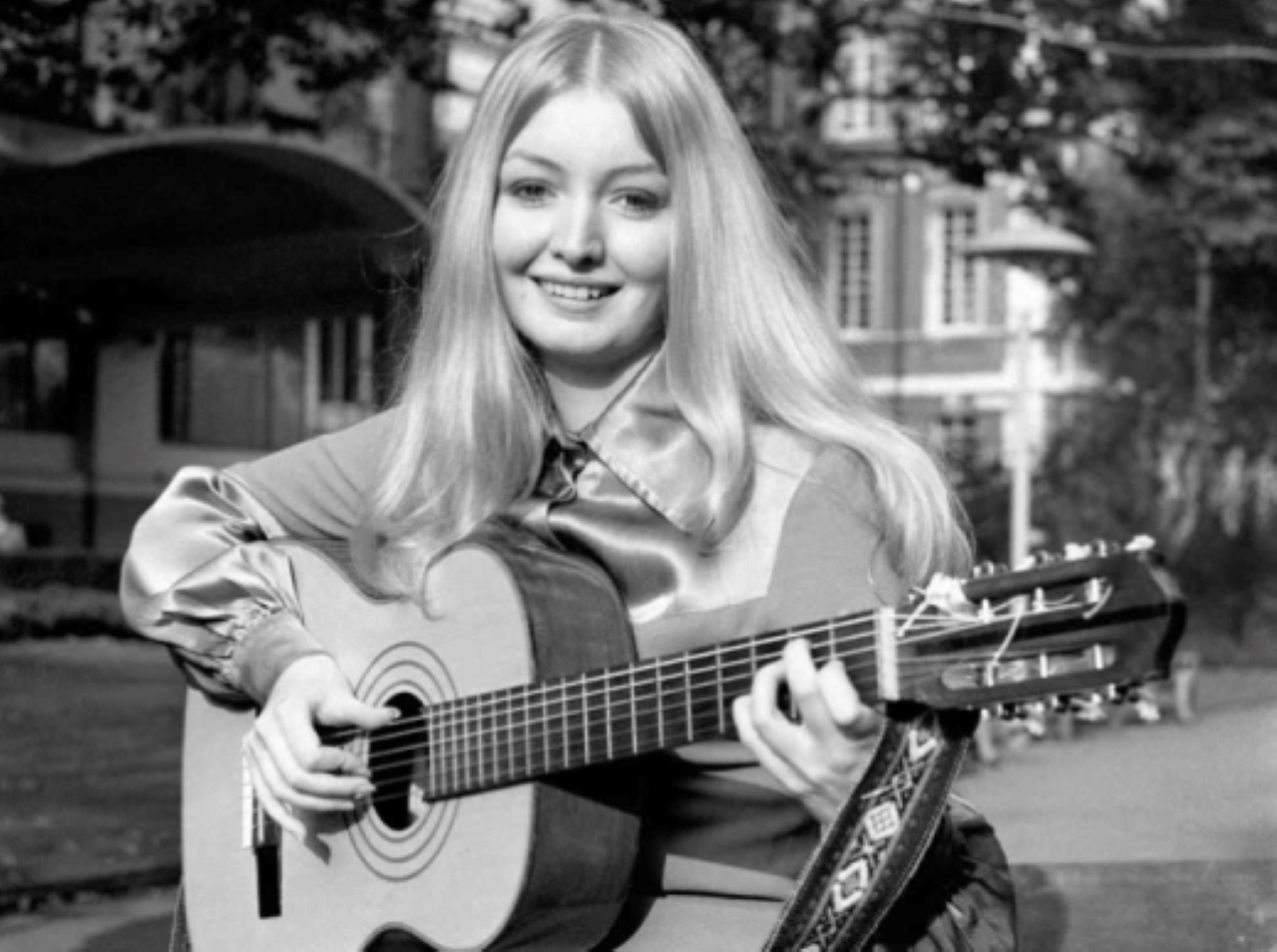🌱 A Folk Girl from Wales
In the late 1960s, while the world was intoxicated by psychedelia, protest songs, and the emerging counterculture, a young Welsh folk singer named Mary Hopkin was living far from the glamour of London. Born in Pontardawe, South Wales, she grew up in a modest household where music was not a career path but a joy shared at home.
Mary had a crystalline soprano voice—gentle, yet commanding in its purity. Unlike the gritty rock singers dominating the charts, she carried the echo of old folk traditions, of songs sung by firelight and stories passed down through generations.
Her first steps into music were humble: she sang with a local band called the Selby Set and Mary, performing folk standards at pubs and small clubs. There was no sense yet that she would become one of the first breakout stars of The Beatles’ Apple Records.

🎤 The Television Break That Changed Everything
Fate intervened in early 1968 when Mary appeared on the popular British TV talent show Opportunity Knocks, hosted by Hughie Green. Her simple presentation—a young girl with a guitar, no gimmicks—stood out against the flashy competitors. She won over audiences week after week with her folk renditions.
One viewer was Twiggy, the iconic model and fashion figure of the Swinging London era. Twiggy, impressed by Mary’s voice, mentioned her to a friend who just happened to be Paul McCartney. At that time, The Beatles were launching their own label, Apple Records, seeking fresh, unconventional talent.
McCartney, intrigued, arranged to meet Mary. What he heard was exactly what Apple needed: authenticity. In an era of distortion pedals and psychedelic excess, Mary Hopkin’s voice felt like a breath of clean air.
🎶 Choosing the Song – “Those Were the Days”
Paul McCartney believed Mary needed a debut single that would both honor her folk roots and also appeal to a global audience. The song chosen was “Those Were the Days”, a traditional Russian romance tune that had already circulated in various forms, but was adapted into English lyrics by Gene Raskin.
Its lyrics carried a wistful nostalgia:
“Those were the days, my friend, we thought they’d never end…”
It was a song about youth, dreams, and the bittersweet passage of time. For Mary, just 18 years old at the time, the sentiment seemed almost ironic—she was only beginning. Yet her voice gave the words a haunting, timeless quality.
The production, overseen by McCartney, combined folk instrumentation with lush orchestration. It was carefully polished but not overbearing, allowing Mary’s voice to shine.
🚀 The Release – Apple Records’ First Big Success
In August 1968, “Those Were the Days” was released as Mary Hopkin’s debut single on Apple Records. The Beatles themselves were fully invested in promoting it. Posters appeared with the slogan: “Mary Hopkin is Apple.”
The song became an instant sensation. In the UK, it shot to No. 1, staying there for six weeks. In the US, it climbed to No. 2 on the Billboard Hot 100, blocked only by The Beatles’ own “Hey Jude.”
What made it extraordinary was its international impact. The song topped the charts in 18 countries, from Germany to Japan, proving that its message of lost youth and universal longing transcended borders.
🌍 A Global Phenomenon
Mary Hopkin was suddenly catapulted into stardom. She performed on TV shows across Europe and America, often introduced as “the girl Paul McCartney discovered.”
Apple Records even released the song in multiple languages, with Mary recording versions in French, Italian, German, and Spanish. This was not just clever marketing; it underscored how global The Beatles’ influence was, and how Mary’s song could belong to everyone.
While rock critics were dissecting the political significance of Dylan or The Rolling Stones, ordinary listeners found comfort in the melancholic beauty of “Those Were the Days.” It was not rebellious—it was reflective. In 1968, a year defined by protests, assassinations, and chaos, the song reminded people of simpler times, of youth’s fleeting magic.
🎼 The Album – Post Card
Following the success of the single, Mary Hopkin released her debut album Post Card in 1969, again produced by Paul McCartney. It included folk covers and traditional songs, but “Those Were the Days” remained the centerpiece.
Interestingly, the album also contained a cover of Donovan’s “Catch the Wind” and Harry Nilsson’s “The Puppy Song.” But nothing could overshadow her debut single’s success. It had already cemented her as a global star.
🌟 The Shadow of Success
The massive triumph of “Those Were the Days” was both a blessing and a burden. On the one hand, Mary Hopkin became a household name overnight. On the other hand, the expectations were immense. Could she follow it up with another hit as big?
Her next single, “Goodbye,” was written by Paul McCartney himself. It reached No. 2 in the UK, another major success, but inevitably compared to her debut, it seemed like a step down.
Mary, shy and grounded, never sought pop stardom. She often felt uncomfortable with the machinery of fame. Unlike many contemporaries, she did not chase the spotlight. Over time, she gradually stepped away from the pop industry, later returning to her folk roots and family life.
💫 Legacy of “Those Were the Days”
Decades later, “Those Were the Days” remains Mary Hopkin’s signature song. It is one of the defining releases of Apple Records, showing that The Beatles’ vision extended beyond their own music.
The track also became a touchstone for the country-rock and folk revival movement that blossomed in the 1970s. Its arrangement, balancing traditional sounds with contemporary pop sensibility, influenced artists who sought to bridge genres.
But most importantly, the song endures because of its universal message. Every generation finds itself reflected in the lyrics—the joy of youth, the dreams we once held, and the bittersweet recognition that time changes everything.
For Mary Hopkin, a teenager from Wales who had no idea she would sing for the world, it was the perfect beginning.
Video